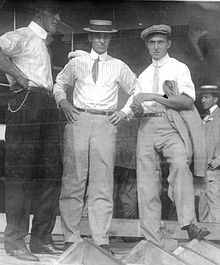A. Roy Knabenshue
Augustus Roy Knabenshue | |
|---|---|
 From left to right are: Frank Trenholm Coffyn; Roy Knabenshue; and Walter Brookins in Atlantic City in 1910 | |
| Born | July 15, 1875 |
| Died | March 6, 1960 (aged 84) |
| Resting place | Portal of the Folded Wings |
Augustus Roy Knabenshue (July 15, 1875 – March 6, 1960) was an American aeronautical engineer and aviator.[1]
Biography[]



Roy Knabenshue was born July 15, 1875, in Lancaster, Ohio, the son of Salome Matlack and Samuel S. Knabenshue. Samuel Knabenshue, an educator and political writer for the Toledo Blade for many years, served as U.S. consul in Belfast, Ireland, from 1905 to 1909 and as consul general in Tianjin, China, from 1909 to 1914.[2] In 1904, at the Louisiana Purchase Exposition, Roy Knabenshue piloted Thomas Scott Baldwin's California Arrow dirigible to a height of 2,000 feet (610 m) and was able to return to the takeoff point.[3]
Knabensue continued working for Baldwin for the next year, operating the Californian Arrow at events around the country. He was the first to make a dirigible flight over New York City in 1905.[4]
In September 1905, Knabenshue stopped in Columbus, Ohio, for a flight at the Ohio State fair. While he was there, he had a falling out with Baldwin over his pay. Knabenshue copied Baldwin's design and built his own airship, which he named Toledo I. He stayed on at the fair and made two ascensions a day. While there, he also met and mentored Cromwell Dixon, who at the age of fifteen was already an aspiring aviator.[5]
In 1913 Knabenshue built the first passenger dirigible in America: White City. He performed barnstorming and worked as the general manager of the Wright Exhibition Team. From 1933 to 1944 he worked for the National Park Service and then worked for a Los Angeles, California, firm reconditioning used aircraft.
In 1958 he had a stroke. He had a second stroke at his home at a trailer park in Arcadia, California, on February 21, 1960. He died on March 6, 1960, at the in Temple City, California.[1]
Interment and services were held March 9, 1960, at the Portal of the Folded Wings in Valhalla Memorial Park Cemetery in North Hollywood, California.
References[]
- ^ Jump up to: a b "First Flier in U. S. to Pilot Lighter-Than-Air Craft Dies". The New York Times. March 7, 1960. Retrieved 2011-11-14.
Roy Knabenshue, an aviation pioneer who was the first man to fly a powered lighter-than air craft in the United States died today of a stroke in ...
- ^ Carroll, Francis M. (2005). The American Presence in Ulster: A Diplomatic History, 1796-1996. Washington, D.C.: Catholic University of America Press. pp. 109–110.
- ^ "Dirigible Anniversary". The New York Times. October 28, 1944. Retrieved 2011-11-14.
Forty years ago this week the first successful flight of a dirigible airship in this country was made. A. Roy Knabenshue took off from the aeronautic concourse of the St. Louis World's Fair grounds in Capt. Thomas Scott Baldwin's "California Arrow," and after a flight of one hour and thirty-one minutes landed eleven miles away in St. Clair County, Ill. ...
- ^ "Knabenshue's Airship Sails Over The City. From Central Park To The Times Building And Back. Steered With Perfect Ease. Aeronaut Up 1,000 Feet In The Air. Traveled More Than Two Miles. Thousands Watch Him. Knabenshue's Airship Sails Over The City". The New York Times. August 21, 1905. Retrieved 2011-11-14.
New York had its first view yesterday of a real airship or dirigible balloon. The former designation is for the benefit of those who believe that aerial flight will be the principal means of rapid transit in the near future. The second term, however, best suits A. Roy Knabenshue of Toledo, Ohio, the inventor, constructor, and navigator of the machine in which he sailed from Central Park south over the city yesterday afternoon. ...
- ^ Phillips, Del (Autumn 2009). "Cromwell Dixon: The World's Youngest Aviator". Montana The Magazine of Western History. 59 (3): 50. JSTOR 40543653. Retrieved 13 February 2021.
External links[]
- Wright brothers
- American balloonists
- Aviators from Ohio
- Members of the Early Birds of Aviation
- Burials at Valhalla Memorial Park Cemetery
- 1875 births
- 1960 deaths

